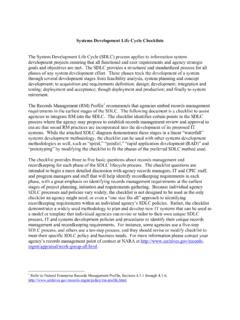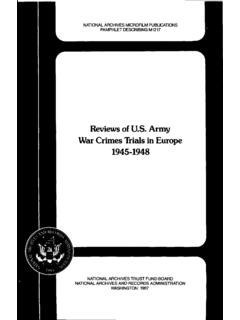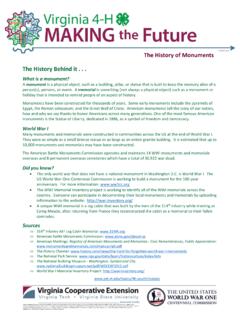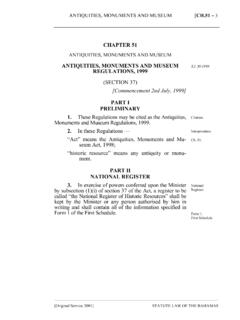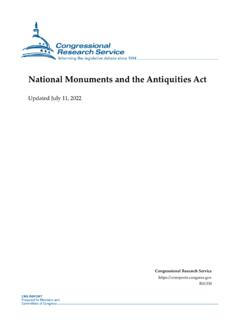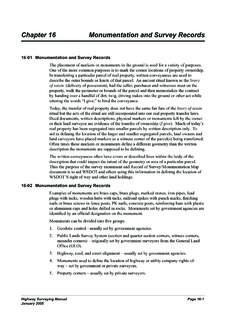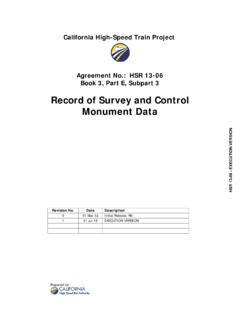Transcription of monuments men treasures and nazi - National Archives and ...
1 Occupation Forces Faced a Myriad of Problems In Sorting Out Riches Hidden by the Third Reich by GreG Bradsher monuments men and nazi treasures In late Januar y 1945, Russian troops moved closer to the massive Tannenberg Memorial near Hohenstein, in what is now Olsztynek in northern Poland near the Baltic Sea. It commemorated the German soldiers killed there in World War it was a battle in which the German commander, Paul von Hindenberg , who was later elected president, became a hero. Colonel-General Hans Reinhardt, commander of Army Group Center, ordered the memorial to be blown up, but not before certain things were removed.
2 Those things were the bodies of Field Marshal and Weimar President von Hindenburg and his wife. Lt. Gen. Oskar von Hindenburg supervised the evacuation of the flags of the Prussian regi ments and the coffins of his parents, which were moved to Berlin. Thus began what a 1950 Life magazine article called one of the most curious and complicated enterprises the Army of Occupation ever undertook. It was perhaps one of the most unlikely and interest ing World War II German cultural property evacuation endeavors.
3 The story involves four caskets; military flags; famous artwork; the Hohenzollern Museum treasure (from the Monbijou Palace in Berlin), including the crown jewels and the coronation paraphernalia of Frederick William I; and cultural treasures . In March 1945, the German Army transported the caskets of the Hindenburgs, Frederick the Great, and Frederick William I, as well as the cultural items named above, to a one-time salt mine in the northern reaches of the Thuringian Forest, about 18 miles southwest of Nordhausen, that had been converted to a munitions plant and storage depot.
4 There, German Army officers supervised 2,000 Italian, French, and Russian forced laborers working in the plant. About 400,000 tons of ammunition and other military supplies were stored in the mine. A group of large warehouses adjacent to the entrance into the shaft contained munitions, signal supplies, cloth ing, and other military stores. A large store of dynamite was located in relatively close proximity to the depository in the mine. Two rooms in the mine already stored records. German officers sent all civilians out of the area in mid-March.
5 Working with great secrecy and using only military personnel, they brought objects into the mine. In a room measuring roughly 45 x 17 feet, they placed the caskets of Prussian kings Frederick William I (reign 1713 1740) and Frederick the Great (1740 1786), both of whom had been buried in the church of the Potsdam garrison, and of Field Marshal and Frau Gertrud von Hindenburg. Three of the caskets were made of wood; the fourth, containing the remains of Frederick the Great, was metal and larger than the others.
6 Each casket bore a paper label fastened with cellophane tape. In the same room the soldiers also placed treasures from the Hohenzollern Museum in Berlin. Each item had an identifying card attached. Most of the items had been made for or used at the coronation of King Frederick I and Queen Sophie in 1701. More than 200 German regimen tal flags, some painted and some embroidered, were hung above the coffins. They dated from the early Prussian wars and included many from the World War I era. A variety of other cultural items were placed in the room, and the entrances were sealed with brick and mortar on April 2.
7 Officers with Art Expertise Arrive to Supervise Operations The items were not concealed for long. By the end of April, the mine treasure would be in American hands. Not long afterward, the caskets, paintings, and flags would be stored in Marburg, awaiting political decisions as to what to do with them. Marburg is situated on a hillside along the Lahn River, 60 miles north of Frankfort. From a military standpoint in 1945, Marburg was important for its marshalling yards at the south end of town, which were used for the transship ment of German military personnel and supplies.
8 The Army Air Forces bombed the yards four times in March. The historic buildings in the central part of the town were undamaged from these bombings, but the new Staatsarchiv Building (occupied in 1938), suffered moder ate damage. Not long after the last aerial bombardment of Marburg, the American military forces entered the town and cap tured it by the end of March. Opposite: The casket of Frederick the Great is removed from the Bernterode cave southwest of Nordhausen, Germany, in April 1945. Prologue 13 monuments Men and nazi treasures When American forces entered the Bernterode salt mine in April 1945.
9 They found four caskets in a chamber. The coffin of Frederick Wilhelm I is not pictured. Left, top: Frederick the Great; bot-tom: Frederick's bronze coffin draped with a nazi flag. Center, top: Field Marshal and President Paul von Hindenburg; bottom: von Hindenburg's coffin. Above: The casket of Frau von Hindenburg in the Bernterode cave. Soon thereafter, in early April, Capt. Walker K. Hancock inspected the pri mary cultural institutions and locations.
10 Hancock was an officer specialist with the monuments , Fine Arts, and Archives (MFA&A) Section, whose members were known as the monuments Men. As a re nowned sculptor, Hancock had won the prestigious Prix de Rome before the war and designed the Army Air Medal in 1942. At the castle, he found three great halls packed with parcels from the Staatsarchiv and Marburg town Archives . At the Staatsarchiv he found that the building and its archival holdings had sustained greater damage from the occupying troops than from the bombs.


